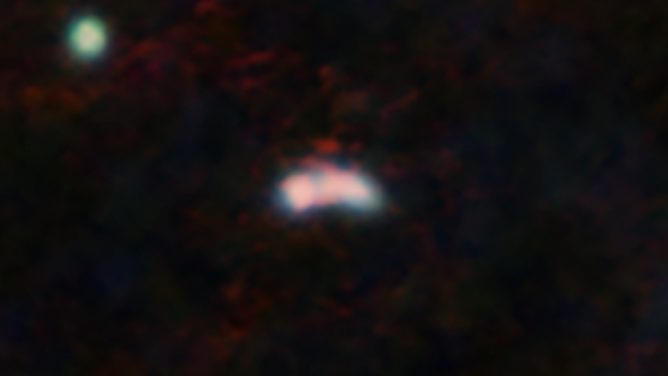2023.10.06
Astronomers Discover First Step Toward Planet Formation

Figure 1: An image of the radio wave strength at a wavelength of 1.3 mm of the disk around the star DG Taurus, observed with ALMA.
Unlike older protostellar disks, ring-like structures have not yet formed, suggesting that the disk is at the stage just before planet formation. Credit: ALMA (ESO/NAOJ/NRAO), S. Ohashi et al.
Solving the mystery of how planets like Earth were formed is an important question for understanding the origin of life. Planets are thought to form when interstellar dust and gas collect in a protoplanetary disk surrounding a protostar, but it has been unclear where, when, or how planet formation begins. On the other hand, it is known that when a planet is formed within a disk, its gravity creates a ring-like pattern on the disk. In fact, observations with ALMA have revealed such ring structures in many protoplanetary disks, suggesting the existence of planets. In order to study the planet formation process, it is necessary to take a detailed look at disks where it is certain that no planets exist yet. However, due to the difficulties of finding such disks with no signature of planets and studying them in detail, we do not yet have a clear picture of how planet formation begins.
In this study, the international research group focused on a relatively young protostar, DG Taurus (DG Tau), and studied the disk surrounding the protostar in detail with ALMA. They observed the distribution of radio emission intensity at a wavelength of 1.3 mm emitted by the dust in the disk with an extremely high spatial resolution of 0.04 arcsec, and clarified the detailed structure of the disk. The results show that the disk around DG Tau is smooth and lacks the ring-like patterns seen in the disks around older protostars. This indicates that there are no planets in the disk of DG Tau, and the image may have captured the eve of planet formation.

Figure 2: (Top) Radio wave strength maps of the DG Tau disk at wavelengths of 0.87 mm, 1.3 mm, and 3.1 mm observed with ALMA and polarization strength maps of radio waves scattered by dust at wavelengths of 0.87 mm and 3.1 mm. (Bottom) The simulation which provides the best agreement with the above observations.
Credit: ALMA (ESO/NAOJ/NRAO), S. Ohashi et al.
They further observed the disk at different wavelengths (0.87 mm, 1.3 mm, and 3.1 mm) and investigated the radio wave and polarization intensities. Depending on the dust size and dust density, the ratio of radio wave intensities at different wavelengths and the polarization intensity of the radio waves scattered by the dust change. Therefore, the size and density distribution can be estimated by comparing the observation results with simulations with various patterns of dust size and density distribution. This reveals the extent to which interstellar dust, the material from which planets are made, is growing. The best-fit simulations suggest that the dust is larger in the outer part of the disk (beyond about 40 astronomical units ; a little farther than the distance between the Sun and Neptune in the Solar System) than in the inner part, indicating that the planet formation process is more advanced. Theories of planet formation have suggested that planet formation begins in the inner part of the disk, but the results of this study contradict this expectation and indicate that planet formation may begin from the outer part of the disk. On the other hand, the dust to gas ratio was found to be about 10 times higher than in normal interstellar space in the inner region, although the dust size is smaller. Furthermore, these dust particles are well settled down onto the disk midplane, suggesting that the disk is in the process of accumulating material to form planets. It is possible that planet formation may be triggered by this dust accumulation in the future.
These observations were made possible by ALMA’s extremely high spatial resolution of 0.04 arcseconds, as well as by the observation of radio waves emitted by the dust, including polarized light at three different wavelengths. This is the first time that the size and density of dust in a “smooth disk” with no signature of planets has been revealed. This has provided new information about planet formation sites that could not have been predicted by previous theoretical studies or observations of disks with signatures of planet formation. Commenting on the significance of this research, Satoshi Ohashi says, “ALMA has so far succeeded in capturing a wide variety of disk structures and has revealed the existence of planets. On the other hand, however, to answer the question, ‘How does planet formation begin?’, it is important to observe a smooth disk with no signature of planet formation. We believe that this study is very important because it reveals the initial conditions for planet formation.”
This research has been published in The Astrophysical Journal on August 28, 2023 as “Dust Enrichment and Grain Growth in a Smooth Disk around the DG Tau Protostar Revealed by ALMA Triple Bands Frequency Observations” (DOI: 10.3847/1538-4357/ace9 b9.).
This project is also supported by Grants-in-Aid from the Japan Society for the Promotion of Science (KAKENHI: Nos. JP18H05441, JP19K23469, JP20K04017, JP20K14533, JP20H00182, JP22H01275, JP23H01227), the RIKEN pioneering project of Evolution of Matter in the Universe, the DFG-Grant “INSIDE: The INner regions of protoplanetary disks:SImulations anD obsErvations” (project No. 465962023), the EC H2020 research and innovation programme for the project “Astro-Chemical Origins” (ACO, No. 811312) and the PRIN-MUR 2020 MUR BEYOND-2p (Astrochemistry beyond the second period elements, Prot. 2020AFB3FX).
The Atacama Large Millimeter/submillimeter Array (ALMA), an international astronomy facility, is a partnership of the European Organisation for Astronomical Research in the Southern Hemisphere (ESO), the U.S. National Science Foundation (NSF) and the National Institutes of Natural Sciences (NINS) of Japan in cooperation with the Republic of Chile. ALMA is funded by ESO on behalf of its Member States, by NSF in cooperation with the National Research Council of Canada (NRC) and the National Science and Technology Council (NSTC) in Taiwan and by NINS in cooperation with the Academia Sinica (AS) in Taiwan and the Korea Astronomy and Space Science Institute (KASI).
ALMA construction and operations are led by ESO on behalf of its Member States; by the National Radio Astronomy Observatory (NRAO), managed by Associated Universities, Inc. (AUI), on behalf of North America; and by the National Astronomical Observatory of Japan (NAOJ) on behalf of East Asia. The Joint ALMA Observatory (JAO) provides the unified leadership and management of the construction, commissioning and operation of ALMA.









